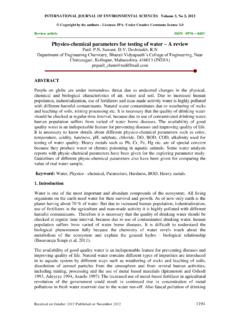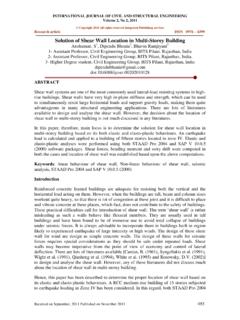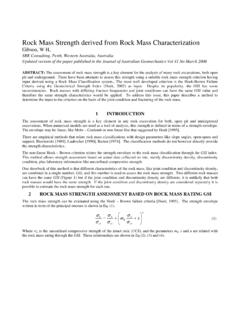Transcription of Correlation of sandstone rock properties obtained …
1 INTERNATIONAL JOURNAL OF CIVIL AND STRUCTURAL ENGINEERING Volume 4, No 1, 2013 Copyright by the authors - Licensee IPA- Under Creative Commons license Research article ISSN 0976 4399 Received on June 2013 Published on August 2013 1 Correlation of sandstone rock properties obtained from field and laboratory tests Mostafa Abdou Abdel Naiem Mahmoud Associate professor, Civil Engineering Department, Assiut University, Assiut 71516, Egypt Civil Eng .Department, Faculty of Eng., Aljouf University, KSA doi: ABSTRACT The unconfined compressive strength of rocks plays an important role in many practices for geotechnical engineering. It is used to determine the bearing capacity of soil specially rocks . The real value of this parameter requires a special technique such as undisturbed samples.
2 So, prediction of unconfined compressive strength of sandstone rocks with the help of rock quality designation (RQD) provides a good opportunity to obtain this parameter without using of more laboratory tests. The RQD is commonly used for rock description or classification, and ..etc. Correlation of properties obtained from field and laboratory tests is considered the most important challenge for geotechnical engineers to save time, effort and many tests. This study was undertaken in order to quantify the variation of the values of unconfined compressive strength due to variation of (RQD). Many field boreholes have been investigated for this purpose. Unconfined compressive strength tests were conducted using samples of different values of RQD. This paper proposed a new empirical equation to predict the unconfined compressive strength for sandstone rock. Keyword: sandstone , unconfined compression strength, RQD, tests, jointing, fracture.
3 1. Introduction Most problems in soils and construction involve either the strength of the in-situ soil or the compressibility of the soil mass. For purposes of design it is necessary to represent, in equations of engineering mechanics the corresponding numerical values representing an appropriate in-situ property. Strength values determined from laboratory testing of intact soil cores are recognized as not being directly applicable to the in-situ soil mass because of the scale effect. Presence of joints in sandstone rock (sedimentary rock type) has rendered it to be discontinuous in nature. Expressed in terms of Rock Quality Designation (RQD), this discontinuous to nature makes sandstone mass to behave differently than intact samples used in laboratory tests. Some forms of reduction on the properties must be applied as intact sandstone rock is usually stronger than a discontinuous mass.
4 The rock quality designation (RQD) index was introduced 20 years ago at a time when rock quality information was usually available only from geology descriptions and the percentage of core recovery. The RQD is modified core recovery percentages in which unrecovered core, fragments and small pieces of rock, and altered rock are not counted so as to downgrade the quality designation of rock contain these feature (Deere, 1988). In soil masses, the existence of discontinuities makes the material properties of soil masses differ greatly from that of intact soils. Although sandstone masses are composed of intact sandstone samples and discontinuities, the deformation of sandstone masses occurs mainly in the discontinuities, Correlation of sandstone rock properties obtained from field and laboratory tests Mostafa Abdou Abdel Naiem Mahmoud International Journal of Civil and Structural Engineering Volume 4 Issue 1 2013 2especially when subjected to low stress state.
5 Experiments have also shown that the permeability of rock masses is primarily on the discontinuities (Jiang, et al., 2009). In engineering applications, RQD is usually calculated as the percentage of the borehole core in a drill run consisting of intact lengths of greater than or equal to 100 mm, which can be mathematically expressed as nxiRQD%100xi=1= Where xi are the lengths of the individual pieces of core in a drill run having lengths 100 mm and x is the total length of the drill run. Many engineers have frequently determined the soundness of rock masses through only the RQD combined with their own experiences. The rock quality designation (RQD) rough measure of the degree of jointing or fractures in rock mass and affect in the permeability of rock mass. The RQD is a modified percent core-recovery which incorporates only sound pieces of core that one 100mm (4inch) or greater in length along the core aims (Singh & Goel, 1999).
6 It is commonly used for rock description or classification, and ..etc. This parameter is routinely performed in field while boreholes are performed. However there is also potential to use the rock quality designation (RQD) as a basis for estimating rock behavior, end bearing capacity of rock socketed shafts (Zhang, 2010). Theoretically representing the rock quality designation (RQD) provides several benefits. First, the sandstone rocks may be classified using this parameter. Second, it is used to estimate or prediction the bearing capacity of sandstone rock. Third, a mathematical equation can provide a method of representing the entire curve between measured data and unconfined compressive strength of sandstone rocks . Numerous methods have been developed for determination the unconfined compressive strength. These methods include the field and laboratory tests. Also, to determine the real value of unconfined compressive strength of rocks , special techniques should be followed such as undisturbed samples and initial overburden pressures should be taken into consideration.
7 On the other hand, only the rock quality designation (RQD) does not depend on undisturbed sample. The interpretation of the rock quality designation (RQD) is typically carried out using field samples. Unconfined compressive strength (Qu) is a means of determining the ability of a sandstone rock to withstand loading pressures. It is an important consideration in the design of structures that will be supported by the rock, as it is used in calculating how much stress, or weight, the rock will initially support. To determine Qu, pressure is applied to a cylinder of the sandstone rock mass until it fails, the data gathered is charted, and the unconfined compressive strength is derived. The engineering properties of sandstone rocks have great importance in designing surface and subsurface structures, in slope stability analysis, and for the design of drifts, ore passes, tunnels, and rock caverns.
8 Mining methods based on caving and blocking of the ore, such as sublevel caving and block caving, also, require knowledge of rock strength. Furthermore, Knowledge of rock strength is of great importance in order to reduce potential settling of rock foundations (Naderi, 2011). The rock quality designation (RQD) has been extended to other areas of rock mechanics, and it has become a fundamental parameter in geotechnical engineering. The success of the RQD is due, in large part, to its simple definition as mentioned in equation (1). However, this index is affected by a number of well known limitations. For instance, its value can be different for a given location when obtained from cores with different drilling orientations. In additions, the RQD may be affected by the rock strength and core size (Li, et al., 2009). For RQD Correlation of sandstone rock properties obtained from field and laboratory tests Mostafa Abdou Abdel Naiem Mahmoud International Journal of Civil and Structural Engineering Volume 4 Issue 1 2013 3determination, the International Society for Rock Mechanics (ISRM) recommends a core size of at least NX (size ) drilled with double-tube core barrel using a diamond bit.
9 Artificial fractures can be identified by close fitting of cores and unstained surface. All the artificial fractures should be ignored while counting the core length for RQD. A slow rate of drilling will also give better RQD. The relationship between RQD and the engineering quality of the rock mass as given in Table 1. Also these ratios are approximately used for field/laboratory compressive strengths. When cores are not available, RQD may be estimated from number of joints (discontinuities) per unit volume Jv (Keykha and Haut, 2011). A simple relationship which may be used to convert Jv into RQD for clay-free rock masses is RQD = 115 (2) Where Jv represents the total number of joints per cubic meter or the volumetric joint count. Large scale rock mass characterization introduces several material parameters in relation to mechanical properties . Two of the most important ones are the deformation modulus and the unconfined rock mass strength.
10 These material parameters are frequently related to laboratory data characteristics of intact rock samples and to the classical rock mass classification systems such as RQD. There are several empirical relations between the rock mass mechanical parameters (unconfined compressive strength, deformation modulus) and of the rock mass classification systems. These uniformly show increasing deformation modulus and compressive strength with the increasing quality of the rock mass (RQD), (V n and V s rhelyi, 2010). Table 1: Description of rocks according to RQD Rock quality RQD (%) No Very poor 25 1 Poor 25 50 2 Fair 50 75 3 Good 75 90 4 Excellent 90 100 5 This study was undertaken in order to know the Correlation of properties obtained from field and laboratory tests, and specially, to quantify the variation of the values of unconfined compressive strength of sandstone rock due to variation of rock quality designation (RQD).











